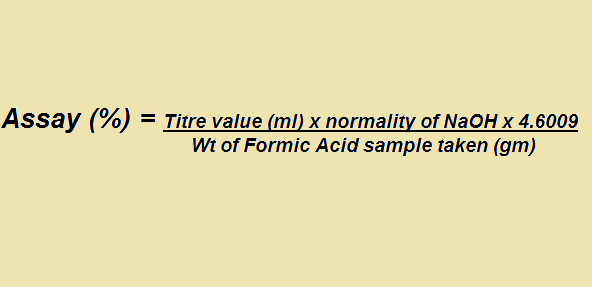The determination of formic acid assay by the titration method.
APPARATUS
a). 5 ml stoppered weighing bottle.
b). 250 ml conical flask.
c). 100 ml measuring cylinder.
d). Burette.
REAGENTS OF FORMIC ACID
a). Standard 1(N) sodium hydroxide (NaOH) solution.
b). Phenolphthalein indicator solution.
PROCEDURE OF FORMIC ACID PURITY
Take a Formic Acid sample in a 5 ml stoppered weighing bottle.
From this carefully transfer about 1 gm(weighing accurately) sample into a 250-ml conical flask.
Add about 100-ml distilled water and shake well to mix properly.
Titrate against standard 1(N) sodium hydroxide (NaOH) solution taken in a burette using phenolphthalein as indicator.
Assay (%) = Titre value (ml) x normality of NaOH x 4.6009/Wt of Formic Acid sample taken (gm).
Formic Acid Uses
1. It is used as a dyeing and tanning agent in the textile and leather industries.
2. It is utilized as a coagulant in the production of latex rubber.
3. It is used as a preservative and antibacterial agent in livestock feed and silage to prevent the growth of mould and bacteria.
4. It is employed in cleaning agents and disinfectants due to its antibacterial properties.
5. Formic acid is a valuable reagent in organic synthesis, used in various chemical reactions to produce a range of other compounds.
6. It is sometimes used as a deicing agent on airport runways and roads due to its ability to lower the freezing point of water.
7. It is used in pesticides and insecticides.
8. In some industrial processes, it is used as a pH adjust solutions.
9. It is used as a mobile phase in high-performance liquid chromatography (HPLC) for the analysis of various compounds.
10. It is used as an acidity regulator and antimicrobial agent in some food products, although its use in the food industry is more limited due to its strong acidity and pungent odor.

